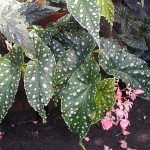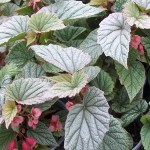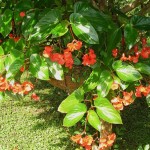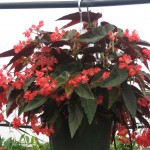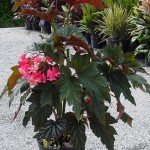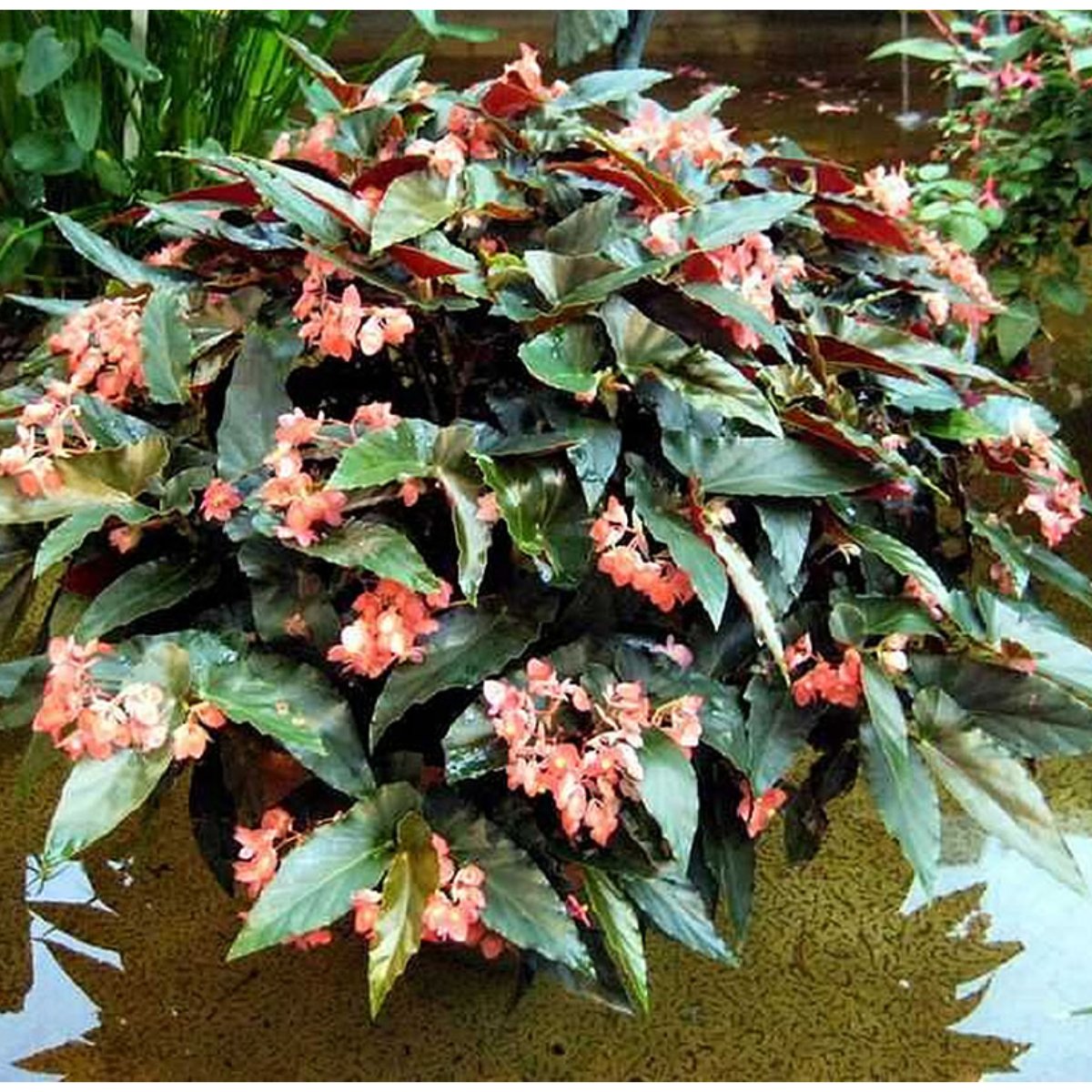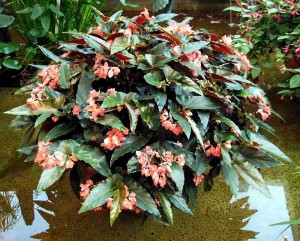Family: Begoniaceae
Synonymous: Pritzelia coccinea
Distribution and habitat: Begonia coccinea plants occur primarily in Central and South America growing in shady and humid spots of Atlantic forest.
They are popularly grown as ornamentals because of their beautifully shaped and colourful foliage and flowers.
Description: Begonia coccinea has only a few bamboo-like stems up to 1m (3 feet) tall. Leathery, obliquely oblong to ovate leaves are 10-15cm (4-6 inch) long and 5-8cm (2-3 inch) wide with slightly toothed, undulate edges. Leaf surface is grass green tinged at the edges with red above and dull red bellow. The leaves are arranged asymmetrical on stems.
Begonia coccinea, with its thick, jointed stems, is an popular fibrous rooted begonia.
The flowers are irregular, unisexuate and in axillary, pendulous cymes with red peduncles. The male flowers have 2 large, pink tepals and 2 small tepals in opposite pairs at right angles to each other. There are numerous stamens with short filaments and yellow anthers. The female flowers have 5 pink tepals of unequal sizes attaches above the inferior ovary. The ovary is three-winged and dark pink with 3 styles and a golden yellow, convoluted stigma.The 1cm (0.4 inch) wide, waxy, coral red flowers appear in large, drooping clusters on red stalks from early summer to mid-autumn.
The fruit is a triangular capsule, up to 8cm (3 inch) long and three winged.
Although Begonia coccinea are herbaceous evergreen perennials,they are susceptible to frost and many cultivars planted in temperate areas are treated as annuals. They are easy to grow, both outdoors and in containers.
Angel Wing Begonia Plant name is coming from its large leaves that are shaped like the wings of an angel and is the common name of a numberof Begonia species.
Houseplant care: Begonia coccinea is primarily grown for its elegant foliage, but it can be a heavy bloomer as well.
Careful pruning of Begonia coccinea canes will keep the plants compact, rounded and in many cases, suitable for hanging baskets. When the new plant is 15cm (6 inch) tall, pinch the top growing shoot; lateral shoots will develop in a few weeks. Allow any extra shoots from the base of the stem to grow since they too will develop a bushier form. If any one cane starts to take over or grows rapidly with only a few leaves, prune it out. When the plant is one year old, prune it drastically down to 15cm (6 inch) both in the winter and again in late spring.
Regularly remove spent flowers to encurage new flowers to develop.
Light: Begonia coccinea needs bright light without direct sunlight to form great foliage.
Place them in a bright east or west window. Bright light intensifies the leaf colourations and promotes good flower development.
When taken outside for the summer, they will prefer partial shade to avoid leaf scorch.
Temperature: Normal room temperatures are suitable for actively growing Begonia coccinea plants. The ideal temperature range is21 to 24C (70-75F) during the daytime and no cooler than 16C (60F) at night, though they will tolerate temperatures as high as 40C (104F) and as low as 10C (50F).
Begonia coccinea will suffer in dry air. For increased humidity stand pots on trays of moist pebbles.
Watering: Water actively growing Begonia coccinea plants moderately, allowing the top couple centimetres (0.8 inch) of the potting mixture to dry out before watering again. During the winter rest period water more sparingly, allowing the top half of the potting mixture to dry out between waterings.
Do not allow the plant to sit in water. Promptly remove the standing water.
Feeding: Apply standard liquid fertiliser every two weeks to actively growing plants. Over-fertilising leads to excessively cane growth.
Potting and repotting: Use either a peat-based mixture or a combination of equal parts of soil based potting mixture and coarse leaf mould. Put a shallow layer of clay-pot fragments in the bottom of pots for extra drainage.
Move the plants into pots one size larger every spring until maximum convenient pot size (probably 15-20cm) has been reached. Thereafter, top-dress annually with fresh potting mixture.
When potting and repotting these plants, simply sprinkle some mixture around the roots and tap the container briskly to settle the mixture. Do not firm it down with the fingers.
Repotting should be done in spring or summer, although Begonia coccinea are better off if slightly pot bound. Too much soil around the roots may waterlog the plant and create root rot. Clay pots are preferred since they dry out faster than plastic pots.
Gardening: Begonia coccinea is a perfect understory plant if light is available. It is a very attractive addition to the garden.
Avoid frost as leaves become damaged and plants can perish.
Begonia coccinea grows at a moderate to fast rate. Cutting back is a good idea because theBegonia coccinea plant gets fuller and the size can be controlled.
Location: Begonia coccinea should be planted in a shadier area in regions where temperatures are typically high and in a less shady area if temperatures tend to be cool. Avoid extreme heat and direct summer midday and afternoon sun. Plants will grow happily in sunny positions outdoors if protected from extremes. This begonia species is quite sun tolerant, but will look and flower its finest with shade for the hottest part of the day. In tropical areas, use this as a tall accent plant in mixed borders or as part of lush foundation plantings. It will thrive dappled shade, making it an useful plant in the garden to add colour underneath trees.
Soil: Humus rich soil that is free draining is best for Begonia coccinea. Make sure the soil is sandy and loamy and has a pH between 6.1 and 7.5 as this plant is a weakly acidic soil or weakly alkaline soil loving plant. Avoid soils that are mucky or are dry, infertile sands.
Prepare the garden by breaking up the existing soil. Add organic matter such as manure, peat moss or garden compost until the soil is loose and easy to work. Organic ingredients improve drainage, add nutrients and encourage earthworms and other organisms that help keeping the soil healthy.
Irrigation: Begonia coccinea has to be moderately watered. Too much or too little irrigation can have an adverse effect on the production of leaves and flowers and on the general health of the plant. This plant is especially susceptible to over-watering. It should be watered whenever the surrounding soil appears to be dry, but it should never be drenched. Use drip irrigation practices rather than just dousing it. Ultimately, over-watering can cause shedding of leaves and buds or flowers, but too little irrigation can be equally harmful. When it does not receive enough water, vital nutrients and minerals are not carried properly through the root system to the rest of the plant and Begonia coccinea health deteriorates. Wilted plant will eventually recover when watered but over-watered plant will die. However, consider this plant as being drought tender. Water the plant when the soil is dry.
Make sure Begonia coccinea has good drainage and watering once a week should be enough to keep the soil barely moist.
Fertilising: Fertilize once a month only from spring to autumn with a dilute liquid fertiliser. Fertilising more often than this results in excessively cane growth.
Propagation: Begonia coccinea ca be propagated by cuttings or seed.
Cuttings propagation: Take a 8-10cm (3-4 inch) long cuttings of nonflowering shoots in spring or early summer. Trim each cutting immediately bellow a leaf, carefully remove the leaf and dip the cut end of the stem in hormone rooting powder. Plant the cutting in a 8cm (3 inch) pot of a moistened equal-parts mixture of peat moss and coarse sand or perlite and enclose the whole in a plastic bag or propagating case. Stand it in bright filtered light until renewed growth indicates that rooting has occurred. It will take about three to six weeks to root. Uncover the rooted cutting and begin to water it sparingly and to apply standard liquid fertiliser about once every two weeks. Do not overwater to avoid rotting. About six months after the start of propagation, move the young plant into a slightly larger pot of standard potting mixture and treat it as a mature plant.
Propagation from seed: seeds are very tiny and should be not buried when sown. Mix them with little fine sand before sowing. Sow seeds trays in any standard germination medium (equal parts of peat and perlite or equal parts of vermiculite and perlite). A light mist spray of the surface will settle the seeds adequately. Keep the propagating trays in warm, moist conditions (intermittent mist ideal) in bright light, but no direct sun.
Prick the seedlings out into individual cells or small pots 6-8cm (2.5-3inch) when the first three leaves are formed. Use same potting mixture as for mature plants. The seedlings benefit from dilute applications of soluble fertiliser every two weeks. Re-potting will be necessary in about six months or so. Pot the new plants in pots one size larger when the root ball fill the pot. Thereafter treat them as mature Begonia coccinea.
Problems:
Leaves turn yellow or brown and fall off as result of overwatering.
Treatment: Keep the plants in small pots (clay pots preferable) and water the plants only when the potting mixture become dry. Cool conditions and oversized pots contribute to this problem.
Tans spots on leaves and plant rot at the base are result of fungal disease (Botrytis).
Treatment: This disease is common with rooted cuttings and is best prevented by using a clean, pathogen-free medium. Discard affected plants and start new plants form clean stem tip cuttings.
Spots with yellow halos on the leaves are results of bacterial leaf spot.
Treatment: Remove affected leaves and increase air circulation. Discard infected winter blooming as they carry these disease throughout their system.
Mildew is not the problem with Begonia coccinea that it can be with other begonias, but fungal disorders can certainly set in if plants are too crowded, watered from overhead or have poor air circulation.
Watch out for mealybugs and aphids on foliage.
Treatment: Control them by dabbing with alcohol-soaked cotton swabs. Repeat the treatment every 5 days until the problem is solved. Do not use oil sprays to control pests on any begonias.
Begonia coccineamay be infected with nematodes, soil-dwelling plant parasites that are more difficult to treat.
Treatment: Many garden shops carry products to control nematodes. A home remedy for these pests is mothballs. Watering the plants with mothballs on the soil surface will help eliminate the nematodes.
Longevity: Begonia coccinea will lose they vigor in time (typically after 4 to 5 years). When the plants begin to lose their vigor, take stem cuttings in the spring or summer and create new healthy plants. In this way the plants will last indefinitely.
Recommended cultivars:
Begonia coccinea 'Flamingo Queen': This cultivar has dark green leaves with varying sizes of silver spots and with silver spotted margins with pink flowers.
Begonia coccinea 'Sinbad': Foliage with a silvery sheen and pink flowers.
Begonia coccinea 'Torch': This is an cultivar with red blooms year round in warm weather. Waxy, arrowhead-shaped leaves are dark green on top and maroon underneath. Upright stem growth with pendulous leaves and flowers. Great hanging basket, or container plant.
Uses and display: Begonia coccinea are prized as much for their attractive foliage as their flowers. This plant tends to be in bloom all year round. This plant is a great attractor for butterflies, bees, and birds, so Begonia coccinea is a great choice for the garden to attract wildlife. It is the perfect choice for beds and borders as well as it is superb for baskets, containers and window boxes. Also Begonia coccinea is an wonderful choice for combination plantings. It is perfect understory plant if light is available.
Begonia coccinea is a very attractive addition to the garden or as an indoor specimen. Indoors can be used as table top plant or hanging basket.
Pruned stems from Begonia coccinea make good cut flowers.
SUMMARY:
CHARACTERISTICS:
Foliage coloured
Shape upright
Height: 1m (3 feet)
PROPER CARE:
Watering in rest period moderately
Watering in active growth period moderately
Light bight
Temperature in rest period min 10oC max 16oC (50-60oF)
Temperature in active growth period min 16oC max 27oC (61-81oF)
Humidity moderate
Hardiness zone: 10a-11

